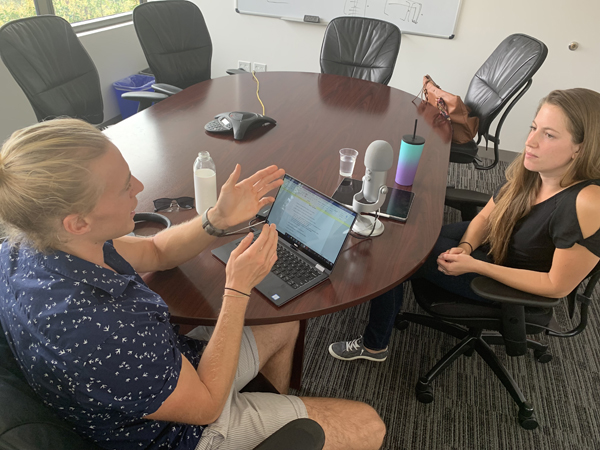A conversation with: Danielle Grotjahn, PhD, Scripps Research Fellow
Published:
August 12, 2019
Author:
Office of Marketing and Communications

Part 1
Where did you get your love of science?
I guess this is a cheesy story, but it is true. I did grow up in Wisconsin and I had always enjoyed the outdoors. My grandparents had some land, so as a kid I loved nature and was constantly exploring. But then when I was about 8 years old, my parents bought me this small microscope kit and it was just awesome. I would swab the inside of my cheek and look at my cheek cells, or find plants to examine. Looking back on it, perhaps getting that kit was a foreshadowing of my love for microscopes. I did always have that curiosity, but it would be a lie to say I always dreamed of being a scientist. I began to develop an interest in different languages and cultures, so by the time I applied to college I knew I wanted to double major in biology and Spanish. I ended up being more drawn to the science through working in a lab as an undergraduate and then being offered a technician position after that. In that lab we were doing really cool time-lapse imaging in zebrafish. We would collect freshly fertilized eggs and then I would literally watch them divide under the microscope, going from a single cell all the way up to the whole organism. Again, this theme and passion for imaging biological specimens.
How have you used biological imaging in your graduate and now independent research? And what are the implications?
I joined Gabe Lander’s Lab here because I wanted to start using cryogenic electron microscopy (cryo-EM). At the time, everyone was obsessed with using cryo-EM to look at purified individual proteins. But I was the weird one; I really wanted to look inside of cells. With cryopreservation, we flash freeze the sample so quickly that the water molecules don’t have time to crystallize; they don’t form the same ice you get in your ice cube tray. They form a glass-like ice that’s thought to be the best way to preserve any sample. Then we’ve taken ideas from materials scientists, using micro-machining instruments and repurposing them for biology. The idea is that you have this beam of ions that you can use to clear away the cellular material above and below your area of interest, making it thin enough to visualize.
Initially I was focused on the motor proteins inside of a cell; the train or highway system of a cell that transports different things around. Now I’m planning to study the mitochondria, which are the energy-producing units of cells and seem to be good sensors of overall cellular health. In the long term I’d like to apply this to study the nervous system. One of the hallmark features of Alzheimer’s and Parkinson’s Disease is fragmented mitochondria, which may in fact be one of the earlier signs of neurodegeneration. If we can understand the network of mitochondria in both healthy and diseased states, then we may be able to come up with strategies to halt these abnormal changes early on as a preventative measure.
What contributed most to your graduate school experience here?
I had a great time here at graduate school. I really liked how flexible the graduate program was; you could decide which classes you wanted to take, you could get leadership experience very easily and you could join all these different clubs. For me, I got involved with the post-docs’ association and I was also the Chair of the Network for Women in Science (NWiS). As well as an NSF graduate research fellowship, the scholarship I received from ARCS was just so impactful. I grew up in a loving home, but money was always an issue for us. Financially, the scholarship was crucial because I could start paying off my student loans earlier while I was still in graduate school. But then there were just so many other unexpected benefits of ARCS too. Just learning about its history was inspiring; that it was started by these visionary women in response to the Sputnik launch, who got together and wanted to make US scientists the most successful they could to compete internationally. I then had the opportunity to speak at their Scientist of the Year dinner event in 2016 which was so rewarding. By having this network of ARCS members and other scholars, it really enriched my graduate experience. I’m very happy to still be in San Diego, which has a very active ARCS chapter here, so I’m looking forward to keeping in touch with everyone.
Click here to learn more about the Skaggs Graduate School of Chemical and Biological Sciences at Scripps Research Learn more about the Scripps Research Fellows Program.

